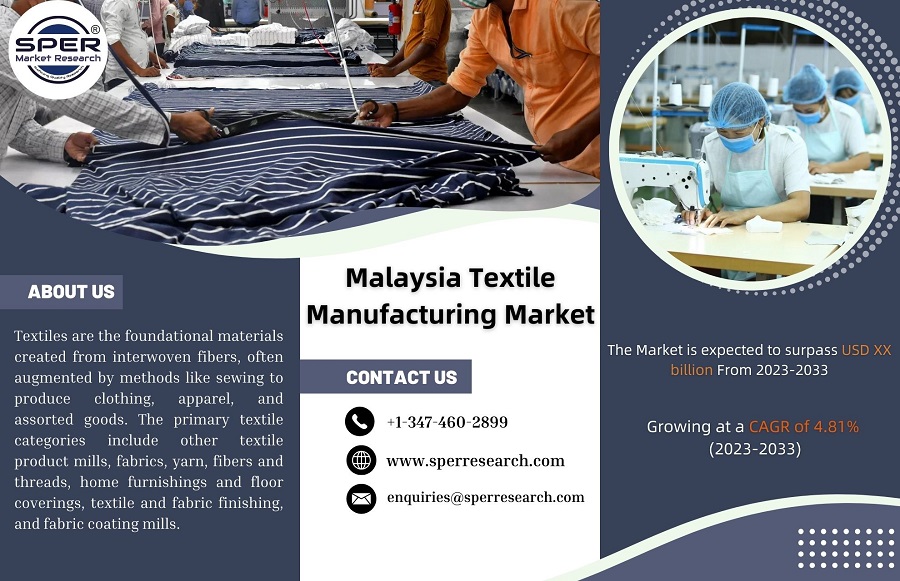Textiles are the foundational materials created from interwoven fibers, often augmented by methods like sewing to produce clothing, apparel, and assorted goods. The primary textile categories include other textile product mills, fabrics, yarn, fibers and threads, home furnishings and floor coverings, textile and fabric finishing, and fabric coating mills.
According to SPER market research, ‘Malaysia Textile Manufacturing Market Size- By Process Type, By Textile Type, By Equipment and Machinery- Regional Outlook, Competitive Strategies and Segment Forecast to 2033’ state that the Malaysia Textile Manufacturing Market is predicted to reach USD XX billion by 2033 with a CAGR of 4.81%.
The Malaysian textile manufacturing sector is exceptionally versatile, encompassing the production of various textiles, including natural and synthetic fibers, yarns, woven and knitted fabrics, non-woven fabrics, as well as bleached, dyed, finished, and printed textiles. Malaysian textile manufacturers are known for their ability to offer ready-to-wear clothing, home textiles, and industrial textiles, which fuels market growth. Muslim women in Malaysia are enthusiastic about investing in designer clothing, as seen with contemporary brands like Tangsi Tujuh and Anaabu, which have modernized traditional Malay attire while preserving its Asian heritage. The increasing participation of women in the workforce, coupled with rising incomes, empowers them to express themselves through modern fashion, making Malaysia an emerging fashion hub. The growing population aged 25-29, inclined toward fast fashion, is expected to drive heightened demand in the apparel industry, consequently boosting the Malaysian textile manufacturing market in the foreseeable future.
The Malaysian textile industry still grapples with several challenges, with the most prominent being the volatile nature of crude oil prices. Textiles can be categorized into natural and synthetic, with synthetic textiles derived from petroleum-based polymers through the polymerization process. As oil serves as the primary raw material for polymers, polymer prices are closely linked to oil prices, which have exhibited fluctuations over the past decade. These price variations subsequently impact the operations of the global textile manufacturing market. The oscillating crude oil prices have compelled suppliers to reduce costs and vendors to adopt cost-cutting measures, including trimming non-essential operational expenses. These factors are expected to impede the expansion of the global apparel and textile industry in the forecasted period.
Request For Free Sample Report @ https://www.sperresearch.com/report-store/malaysia-textile-manufacturing-market.aspx?sample=1
The COVID-19 pandemic had an adverse effect on the market for textile manufacturing in 2020 and 2021. In response, manufacturers changed their sourcing and delivery networks and embraced digital solutions. In the following years, industry development is anticipated as a result of these initiatives. Additionally, the textile industry in the area is continuously innovating, leading to a stable growth trajectory, with the exception of the downturn during the COVID-19 lockout limitations.
The Malaysian government has taken initiatives to promote new firms by reducing laws and initiation procedures, based on which the barriers to entry into the market are low. Additionally, some of the market key players are Asia Brands Berhad, D&Y Textile (Malaysia) Sdn Bhd, San Miguel Yamamura Woven Products Sdn Bhd, Vicmark Fashion Sdn Bhd, Others.
Malaysia Textile Manufacturing Market Key Segments Covered
The SPER Market Research report seeks to give market dynamics, demand, and supply forecasts for the years up to 2033. This report contains statistics on product type segment growth estimates and forecasts.
By Process Type: Based on the Process Type, Malaysia Textile Manufacturing Market is segmented as; Finishing, Knitting, Spinning, Weaving, Other Process Types.
By Textile Type: Based on the Textile Type, Malaysia Textile Manufacturing Market is segmented as; Fabric, Fiber, Garments, Yarn, Other Textile Types.
By Equipment and Machinery: Based on the Equipment and Machinery, Malaysia Textile Manufacturing Market is segmented as; Automated Machines, Console/Assembly Line Installations, Simple Machines.
By Region: This research also includes data for East Malaysia, Peninsular Malaysia, West Malaysia.
For More Information, refer to below link:-
Malaysia Textile Manufacturing Market Research Report
Related Reports:
Follow Us –
LinkedIn | Instagram | Facebook | Twitter
Contact Us:
Sara Lopes, Business Consultant – USA
SPER Market Research
+1-347-460-289974



